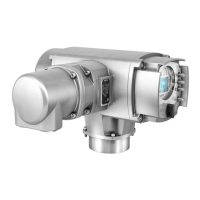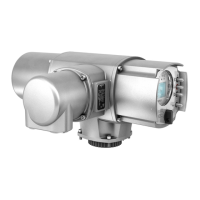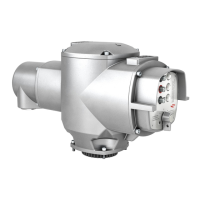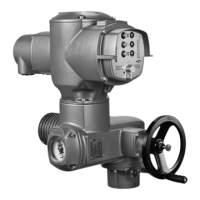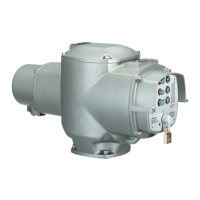Activation M0212
By-pass function M0941
Default value: Function not active
Setting values:
Function not active
Bypass function deactivated.
Function active
Bypass function activated.
8.11.2. By-pass application: configure
The actuators for the two MOVs (valves) have to be configured according to their
application (main or by-pass valve).
Customer settings M0041
By-pass function M0942
By-pass application M0943
Default value: Main valve
Setting values:
Main valve
Actuator for main valve.
By-pass valve
Actuator for by-pass valve.
8.12. Lift Plug Valve (LPV)
Application
A "Lift Plug Valve" is a special valve whose closing element must first be lifted out
of its seat or locking position before being rotated for opening or closing the valve.
Valve locking and/or pressure relief prior to rotation of the closing element can thus
be implemented. Once the end position has been reached, the closing element has
to be lowered again. Such valves are particularly suited in case of significant pressure
differences (pressure relief) and safety-related systems (locking).
Requirements
●
Two actuator controls and actuators are required, one of them is considered
as master actuator (MA), the other one as slave actuator (SA).
●
The actuator controls of the master actuator require an additional <Parallel in-
terface > I/O Interface 2.
Function
Due to the special design of the LPV valves, they can only be operated in
OPEN-CLOSE duty (no modulating duty). For this type of duty, two actuators are
required which are operated as a master-slave-system with main actuator (rotary
movement) and slave actuator (stroke movement). However, only one actuator or
actuator controls are "visible" at the DCS, i.e. the slave actuator is completely
controlled and monitored by the master actuator. Communication between master
and slave actuator is performed via the additional <Parallel interface> I/O Interface
2.
Figure 43: Schematic representation of the function of a Lift Plug Valve
68
Actuator controls
Application functions AC 01.2/ACExC 01.2 Profinet

